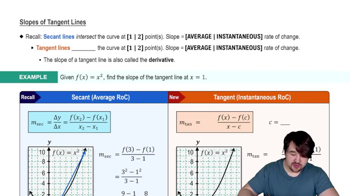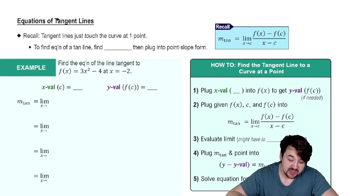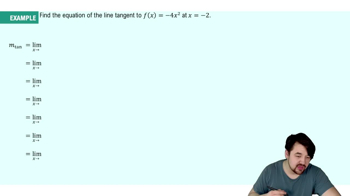Table of contents
- 0. Functions7h 52m
- Introduction to Functions16m
- Piecewise Functions10m
- Properties of Functions9m
- Common Functions1h 8m
- Transformations5m
- Combining Functions27m
- Exponent rules32m
- Exponential Functions28m
- Logarithmic Functions24m
- Properties of Logarithms34m
- Exponential & Logarithmic Equations35m
- Introduction to Trigonometric Functions38m
- Graphs of Trigonometric Functions44m
- Trigonometric Identities47m
- Inverse Trigonometric Functions48m
- 1. Limits and Continuity2h 2m
- 2. Intro to Derivatives1h 33m
- 3. Techniques of Differentiation3h 18m
- 4. Applications of Derivatives2h 38m
- 5. Graphical Applications of Derivatives6h 2m
- 6. Derivatives of Inverse, Exponential, & Logarithmic Functions2h 37m
- 7. Antiderivatives & Indefinite Integrals1h 26m
- 8. Definite Integrals4h 44m
- 9. Graphical Applications of Integrals2h 27m
- 10. Physics Applications of Integrals 2h 22m
2. Intro to Derivatives
Tangent Lines and Derivatives
Problem 3.2.64
Textbook Question
A line perpendicular to another line or to a tangent line is often called a normal line. Find an equation of the line perpendicular to the line that is tangent to the following curves at the given point P.
y= √x; P(4, 2)
 Verified step by step guidance
Verified step by step guidance1
Step 1: Find the derivative of the function y = \sqrt{x}. The derivative, y', represents the slope of the tangent line at any point x. Use the power rule for derivatives: if y = x^{1/2}, then y' = \frac{1}{2}x^{-1/2}.
Step 2: Evaluate the derivative at the given point P(4, 2) to find the slope of the tangent line. Substitute x = 4 into the derivative y' = \frac{1}{2}x^{-1/2} to find the slope at x = 4.
Step 3: Determine the slope of the line perpendicular to the tangent line. The slope of the normal line is the negative reciprocal of the slope of the tangent line. If the slope of the tangent line is m, then the slope of the normal line is -1/m.
Step 4: Use the point-slope form of a line to write the equation of the normal line. The point-slope form is y - y_1 = m(x - x_1), where m is the slope of the normal line and (x_1, y_1) is the point P(4, 2).
Step 5: Substitute the slope of the normal line and the coordinates of point P into the point-slope form equation to find the equation of the normal line.
 Verified video answer for a similar problem:
Verified video answer for a similar problem:This video solution was recommended by our tutors as helpful for the problem above
Video duration:
4mPlay a video:
Was this helpful?
Key Concepts
Here are the essential concepts you must grasp in order to answer the question correctly.
Tangent Line
A tangent line to a curve at a given point is a straight line that touches the curve at that point without crossing it. The slope of the tangent line represents the instantaneous rate of change of the function at that point, which can be found using the derivative of the function.
Recommended video:

Slopes of Tangent Lines
Normal Line
A normal line is a line that is perpendicular to the tangent line at a given point on a curve. Its slope is the negative reciprocal of the slope of the tangent line. This relationship is crucial for finding the equation of the normal line once the slope of the tangent is determined.
Recommended video:

Slopes of Tangent Lines
Finding the Derivative
Finding the derivative of a function is a fundamental concept in calculus that allows us to determine the slope of the tangent line at any point on the curve. For the function y = √x, the derivative can be calculated using power rules, which will then be evaluated at the specific point P(4, 2) to find the slope needed for both the tangent and normal lines.
Recommended video:

The Second Derivative Test: Finding Local Extrema

 5:13m
5:13mWatch next
Master Slopes of Tangent Lines with a bite sized video explanation from Nick
Start learningRelated Videos
Related Practice



